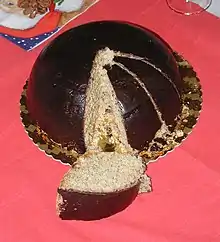Parrozzo
Parrozzo (Italian pronunciation: [parˈrɔttso]) or panrozzo [pan ˈroddzo] is a traditional cake from the Abruzzo region of Italy. It is traditionally served as a Christmas dessert, but may also be enjoyed year round.
 Parrozzo | |
| Course | Dessert |
|---|---|
| Place of origin | Italy |
| Region or state | Abruzzo |
| Main ingredients | sugar, eggs, semolina, almonds, orange or lemon, dark chocolate |
Parrozzo is officially designated as a traditional food product of Abruzzo.[1]
Origins
Parrozo was invented in 1920 by Luigi D'Amico, a bakery owner in Pescara. D'Amico wanted to create a cake that resembled the traditional rough bread made by local farmers with corn flour. Parrozzo has the same round shape as the bread, contains eggs to mimic the yellow of the corn, and is covered with a layer of dark chocolate reminiscent of the burnt surface of the bread.
The first person to try parrozzo was the poet Gabriele D'Annunzio. Afterwards, he composed a madrigal called "La Canzone del Parrozzo" (The Song of Parrozzo), written in Abruzzese dialect:
"È tante ‘bbone stu parrozze nove che pare na pazzie de San Ciattè, c’avesse messe a su gran forne tè la terre lavorata da lu bbove, la terre grasse e lustre che se coce… e che dovente a poche a poche chiù doce de qualunque cosa doce…”
Ingredients and preparation
The dough of parrozzo is made of semolina (alternatively yellow or white flour with corn starch), sugar, eggs, ground almonds, almond extract, and orange or lemon zest. All ingredients are mixed and baked in a round aluminum tray. When the cake has cooled, it is removed from the tray and covered with molten dark chocolate.
References
- Enrico Di Carlo, Gabriele d'Annunzio e la gastronomia abruzzese, Castelli, Verdone, 2010;